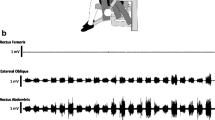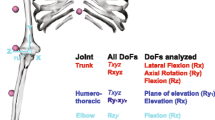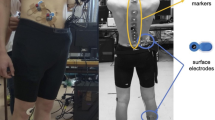Abstract
Gender specific differences as evidenced in both anthropometric data and physical performance of healthy persons have been broadly demonstrated. Recently advancements in surface electromyography (SEMG) have shown possible differences in men’s and women’s muscle coordination patterns. However, quantitative information about gender related muscle co-ordination patterns are rare. This investigation was carried out to both verify if trunk muscle SEMG amplitude–force relationship differs between men and women and refine techniques of measurement and data analysis using SEMG. Thirty-one healthy volunteers (16 women, 15 men) were investigated during whole body tilt at angles from 5° to 90° (from quasi vertical to horizontal position). Subjects had to maintain body in body axis while their lower body was fixed and the upper body remained unsupported. SEMG was taken from five different trunk muscles of both sides simultaneously. At corresponding tilt angles women exhibited higher amplitude levels of their abdominal muscles in comparison to men, who were characterized by higher back muscle amplitudes. Abdominal muscles showed a non-linear SEMG amplitude–force relationship but differed between genders with more linearity in women. Back muscles showed a linear amplitude–force relationship with no differences between genders. Women were characterized by higher levels of co-contraction of all investigated muscles. The data are in accordance with histological investigations, which already proved specific fiber distribution patterns in both abdominal and back muscles and gender related differences in relative area of Type 1 fibers of back muscles. The observed differences in SEMG–force relationship for the abdominal muscles remain hypothetical because of lack of histological information.





Similar content being viewed by others
References
Anders C, Bretschneider S, Bernsdorf A, Erler K, Schneider W (2004) Activation of shoulder muscles in healthy men and women under isometric conditions. J Electromyogr Kinesiol 14:699–707
Anders C, Scholle HC, Wagner H, Puta C, Grassme R, Petrovitch A (2005) Trunk muscle co-ordination during gait: relationship between muscle function and acute low back pain. Pathophysiology 12:243–247
Arendt Nielsen L, Graven Nielsen T, Svarrer H, Svensson P (1996) The influence of low back pain on muscle activity and coordination during gait: a clinical and experimental study. Pain 64:231–240
Bonsell S, Pearsall AW, Heitman RJ, Helms CA, Major NM, Speer KP (2000) The relationship of age, gender, and degenerative changes observed on radiographs of the shoulder in asymptomatic individuals. J Bone Joint Surg Br 82:1135–1139
Carson RG, Riek S (2001) Changes in muscle recruitment patterns during skill acquisition. Exp Brain Res 138:71–87
Clark BC, Manini TM, Ploutz-Snyder LL (2003a) Derecruitment of the lumbar musculature with fatiguing trunk extension exercise. Spine 28:282–287
Clark BC, Manini TM, The DJ, Doldo NA, Ploutz-Snyder LL (2003b) Gender differences in skeletal muscle fatigability are related to contraction type and EMG spectral compression. J Appl Physiol 94:2263–2272
Cooper RG, Holli S, Jayson MIV (1992) Gender variation of human spinal and paraspinal structures. Clin Biomech 7:120–124
Courtenay WH (1998) College men’s health: an overview and a call to action. J Am Coll Health 46:279–290
Denner A (1998) Analyse und Training der wirbelsäulenstabilisierenden Muskulatur. Springer, Berlin
Elfving B, Dedering A, Nemeth G (2003) Lumbar muscle fatigue and recovery in patients with long-term low-back trouble-electromyography and health-related factors. Clin Biomech 18:619–630
Gallagher D, Heymsfield SB (1998) Muscle distribution: variations with body weight, gender, and age. Appl Radiat Isot 49:733–734
Greil H (2001) Körpermaße 2000: aktuelle Perzentilwerte der deutschen Bevölkerung im jungen Erwachsenenalter. Brandenburgisches Umweltforschungszentrum, 2001. http://pub.ub.uni-potsdam.de/volltexte/2005/388/. Cited 24 May 2005
Haggmark T, Thorstensson A (1979) Fibre types in human abdominal muscles. Acta Physiol Scand 107:319–325
Hakkinen K, Komi PV (1983) Changes in neuromuscular performance in voluntary and reflex contraction during strength training in man. Int J Sports Med 4:282–288
Hermens HJ, Freriks B, Merletti R, Stegeman DF, Blok J, Rau G, Disselhorst-Klug C, Hägg G (1999) European recommendations for surface ElectroMyoGraphy, results of the SENIAM project. Roessingh Research and Development b.v., Roessingh
Hodges PW, Richardson CA (1996) Inefficient muscular stabilization of the lumbar spine associated with low back pain. A motor control evaluation of transversus abdominis. Spine 21:2640–2650
Hodges PW, Richardson CA (1998) Delayed postural contraction of transversus abdominis in low back pain associated with movement of the lower limb. J Spinal Disord 11:46–56
Janssen I, Heymsfield SB, Wang ZM, Ross R (2000) Skeletal muscle mass and distribution in 468 men and women aged 18–88 yr. J Appl Physiol 89:81–88
Kankaanpää M, Taimela S, Webber CL, Airaksinen O, Hänninen O (1997) Lumbar paraspinal muscle fatigability in repetitive isoinertial loading: EMG spectral indices, Borg scale and endurance time. Eur J Appl Physiol 76:236–242
Kankaanpää M, Laaksonen D, Taimela S, Kokko SM, Airaksinen O, Hanninen O (1998) Age, sex, and body mass index as determinants of back and hip extensor fatigue in the isometric Sorensen back endurance test. Arch Phys Med Rehabil 79:1069–1075
Keller TS, Roy AL (2002) Posture-dependent isometric trunk extension and flexion strength in normal male and female subjects. J Spinal Disord Tech 15:312–318
Keller A, Brox JI, Gunderson R, Holm I, Friis A, Reikeras O (2004) Trunk muscle strength, cross-sectional area, and density in patients with chronic low back pain randomized to lumbar fusion or cognitive intervention and exercises. Spine 29:3–8
Kerrigan DC, Todd MK, Della Croce U (1998) Gender differences in joint biomechanics during walking: normative study in young adults. Am J Phys Med Rehabil 77:2–7
Lawrence JH, De Luca CJ (1983) Myoelectric signal versus force relationship in different human muscles. J Appl Physiol 54:1653–1659
Lay BS, Sparrow WA, Hughes KM, O’Dwyer NJ (2002) Practice effects on coordination and control, metabolic energy expenditure, and muscle activation. Hum Mov Sci 21:807–830
Lephart SM, Ferris CM, Riemann BL, Myers JB, Fu FH (2002) Gender differences in strength and lower extremity kinematics during landing. Clin Orthop Relat Res 401:162–169
Mannion AF (1999) Fibre type characteristics and function of the human paraspinal muscles: normal values and changes in association with low back pain. J Electromyogr Kinesiol 9:363–377
Mannion AF, Dumas GA, Cooper RG, Espinosa FJ, Faris MW, Stevenson JM (1997) Muscle fiber size and type distribution in thoracic and lumbar regions of erector spinae in healthy subjects without low back pain: normal values and sex differences. J Anat 190(Pt 4):505–513
Mannion AF, Dvorak J, Taimela S, Muntener M (2001) Increase in strength after active therapy in chronic low back pain (CLBP) patients: muscular adaptations and clinical relevance. Schmerz 15:468–473
Marras WS, Jorgensen MJ, Granata KP, Wiand B (2001) Female and male trunk geometry: size and prediction of the spine loading trunk muscles derived from MRI. Clin Biomech 16:38–46
Mayer JM, Graves JE, Udermann BE, Ploutz-Snyder LL (2002) Quantification of the loading characteristics of the upper body and back extension strength on a variable angle Roman chair. J Back Musculoskeletal Rehabil 16:95–104
McGill SM, Grenier S, Kavcic N, Cholewicki J (2003) Coordination of muscle activity to assure stability of the lumbar spine. J Electromyogr Kinesiol 13:353–359
McNair PJ, Depledge J, Brettkelly M, Stanley SN (1996) Verbal encouragement: effects on maximum effort voluntary muscle action. Br J Sports Med 30:243–245
Miller AE, MacDougall JD, Tarnopolsky MA, Sale DG (1993) Gender differences in strength and muscle fiber characteristics. Eur J Appl Physiol Occup Physiol 66:254–262
Mirka GA (1991) The quantification of EMG normalization error. Ergonomics 34:343–352
Mital A, Kumar S (1998) Human muscle strength definitions, measurement, and usage: part I—guidelines for the practitioner. Int J Ind Ergon 22:101–121
Ng JK, Kippers V, Richardson CA (1998) Muscle fibre orientation of abdominal muscles and suggested surface EMG electrode positions. Electromyogr Clin Neurophysiol 38:51–58
Panjabi MM (1992) The stabilizing system of the spine. Part II. Neutral zone and instability hypothesis. J Spinal Disord 5:390–396
Simoneau JA, Bouchard C (1989) Human variation in skeletal muscle fiber-type proportion and enzyme activities. Am J Physiol 257:E567–E572
Smith LK, Lelas JL, Kerrigan DC (2002) Gender differences in pelvic motions and center of mass displacement during walking: stereotypes quantified. J Womens Health Gend Based Med 11:453–458
Solomonow M, Baratta R, Shoji H, D’Ambrosia R (1990) The EMG–force relationships of skeletal muscle; dependence on contraction rate, and motor units control strategy. Electromyogr Clin Neurophysiol 30:141–152
Staron RS, Hagerman FC, Hikida RS, Murray TF, Hostler DP, Crill MT, Ragg KE, Toma K (2000) Fiber type composition of the vastus lateralis muscle of young men and women. J Histochem Cytochem 48:623–629
Thorstensson A, Carlson H (1987) Fibre types in human lumbar back muscles. Acta Physiol Scand 131:195–202
Toft I, Lindal S, Bonaa KH, Jenssen T (2003) Quantitative measurement of muscle fiber composition in a normal population. Muscle Nerve 28:101–108
van Dieen JH, Cholewicki J, Radebold A (2003) Trunk muscle recruitment patterns in patients with low back pain enhance the stability of the lumbar spine. Spine 28:834–841
Zaciorskij WM, Aruin AS, Selujanow WN (1984) Biomechanik der menschlichen Bewegungsapparates. Sportverlag, Berlin
Zazulak BT, Ponce PL, Straub SJ, Medvecky MJ, Avedisian L, Hewett TE (2005) Gender comparison of hip muscle activity during single-leg landing. J Orthop Sports Phys Ther 35:292–299
Acknowledgments
The authors wish to thank Mrs Elke Mey for technical assistance and Ms Marcie Matthews for language correction.
Author information
Authors and Affiliations
Corresponding author
Rights and permissions
About this article
Cite this article
Anders, C., Brose, G., Hofmann, G.O. et al. Gender specific activation patterns of trunk muscles during whole body tilt. Eur J Appl Physiol 101, 195–205 (2007). https://doi.org/10.1007/s00421-007-0490-z
Accepted:
Published:
Issue Date:
DOI: https://doi.org/10.1007/s00421-007-0490-z




